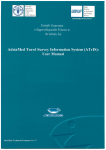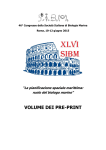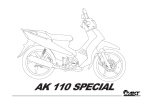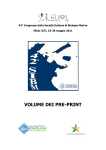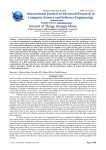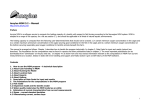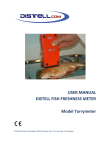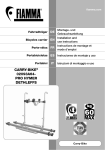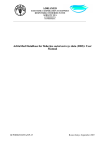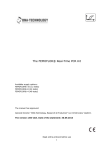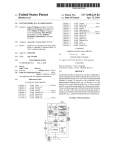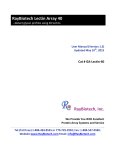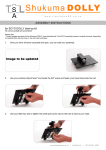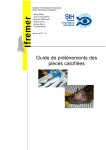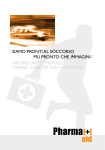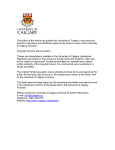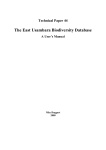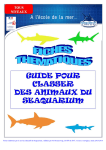Download - AdriaMed
Transcript
SCIENTIFIC COOPERATION TO SUPPORT RESPONSIBLE FISHERIES IN THE ADRIATIC SEA Food and Agriculture Organization of the United Nations MiPAF Italian Ministry of Agriculture and Forestry Policies AdriaMed GCP/RER/010/ITA AdriaMed Trawl Survey Databank: User Manual AdriaMed Occasional Papers No.12 GCP/RER/010/ITA/OP-12 Termoli (Italy), November 2003 AdriaMed Trawl Survey Databank: User Manual Nicoletta Milone, Vincenzo Zeuli, Piero Mannini FAO-AdriaMed This paper should be cited as follows: Milone, N., Zeuli, V., Mannini, P. (2003) AdriaMed Trawl Survey Databank: User Manual. FAO-MiPAF Scientific Cooperation to Support Responsible Fisheries in the Adriatic Sea. GCP/RER/010/ITA/OP-12. AdriaMed Occasional Papers, 12: 18 pp. Available from the World Wide Web at http://www.faoadriamed.org/pdf/OP-12.zip Abstract The first release of the AdriaMed Trawl Survey Databank system is presented. The application has been designed using Microsoft EXCEL© to organize, store and undertake the initial processing and analysis of the data available after the AdriaMed trawl survey of 2001. The background and rationale of the system is illustrated and some guidelines on the use and the utilities related to the system are given. Introduction The AdriaMed Trawl Survey Databank is a computerized system, based on Microsoft Excel© for organizing storing and undertaking the preliminary analysis of the dataset available after the AdriaMed trawl survey of 2001. It was conceived and designed as a simple and common tool to store and perform basic processing of the data collected by the countries participating in the AdriaMed demersal trawl survey. The scope of this manual is to provide users with a brief summary of the various tools available to turn raw data into useful information. These guidelines are composed of two parts: Part 1 describes the background and rationale of the system and Parts 2 and 3 describe the utilities related to the data entry and include instructions on the use of the system. PART 1 1. Background information 1.1 AdriaMed Trawl Survey 2001/2002 In the Adriatic, scientific bottom trawl surveys to monitor and assess demersal fishery resources have been carried out since the 1948-49 (Hvar Expedition). For the most part demersal survey sampling design could cover only national and international waters. Exceptions were the 1982-84 survey, jointly executed by Croatia and Italy in the Northern and Central Adriatic, and more recently, within the EU-funded MEDITS programme the whole Adriatic has been surveyed since 1996, with the exception of Montenegrin waters. Italy has been implementing demersal trawl surveys in national and international waters to 1 the territorial waters of the other coastal countries since 1985. A common approach is needed at regional level when the key demersal resources are straddling stocks across the boundaries between territorial seas and international waters where open access conditions apply. The consideration that the most important commercial stocks of the Adriatic are shared by the national fishing fleets makes it necessary their monitoring and assessment to be carried out over the whole Adriatic Sea. During the 2nd Coordination Committee Meeting held in Slovenia (Portorož, 22-23 November 2000, AdriaMed 2001, GCP/RER/010/ITA/TD-04 refers) the “AdriaMed Trawl Survey”, one of the proposed research activities, was regarded as being of prime interest; its aim was an eastward extension of the Italian demersal trawl survey to include Albanian, Croatian and Slovenian waters. The major intentions were to collect, compile and process data following a common protocol prepared and agreed upon by all researchers involved; to carry out joint data elaboration and analysis and finally to make an appraisal of the status of demersal resources using stock assessment tools. The programme was adopted with the participation of the scientists from four countries: Albania, Croatia, Slovenia and Italy. The programme has several objectives and among the principal aims are: 1) to describe the zoogeographic distribution and pattern occurrence of target species encountered and where possible the relationship of such patterns to observed environmental features (sea depth, sediments, temperature); 2) to estimate relative abundance indices for target species in time and space and finally, where possible to perform stock assessment. 1.2 Trawl Data The AdriaMed Trawl Survey was performed in Autumn 2001 and Winter 2002 within territorial waters of Albania, Croatia and Slovenia. For the execution of the programme two vessels were used: chartered F/V “Pasquale e Cristina” in the national waters of Albania and R/V vessel “Andrea” in the national waters of Croatia and Slovenia. The stations surveyed were 18 for Albania, 22 planned in Croatia but only 17 surveyed, 2 for Slovenia (Annex A). A list of 13 target species was identified taking into consideration the list of priority species whose stocks are shared in the Adriatic Sea as identified by the AdriaMed Working Group on Demersal Resources, and reported in Annex B, Table 5 of the Working Group report (GCP/RER/010/ITA/TD-02 refers, AdriaMed 2000; Group A). The sampling procedures used are similar and coherent with those of the Mediterranean International Trawl Survey (MEDITS) Programme (Bertrand et al., 1996). Catch in weight and number of target and non-target species was recorded and catch rates obtained. For target species biological data such as sex, gonad maturity and length-size composition were recorded. Sampling and sub-sampling procedures utilised “raising factors” in assessment of total numbers individuals caught per species. Data were entered into specially created sheets included as Annex C. The haul logbook held the following information: haul start and end positions and time, total catch weight, bottom depth at haul start and at haul end as well as length of trawl wire 2 released into the sea. Haul timing was 60 minutes, except for Slovenia (39 minutes), irrespective of the trawling depth (stratum). The Italian commercial bottom trawl net (“tartana”) used in the GRU.N.D. programme was constantly utilised with standard auxiliary spare parts (bottom ropes, floating balls, knotless cod-end stretched mesh size was of 20 mm). Horizontal net opening, before surveys, was measured by “Scanmar”-Norway wireless transducers, in stratum of 50-100 meters. In this case the net was 24,2 meters and vertical opening around 1 meter (Annex A, Tables 2, 3 and 4). Figure 1. Map of the stations in AdriaMed 2001/2002 trawl survey program. 1.3. The AdriaMed Trawl Survey Databank Since the AdriaMed trawl survey was carried out, the need to have easily available and to utilize the large amount of collected data was identified. The creation of a regional logical databank holding all the data collected by country and for the whole region was undertaken. The idea was to design a simple system to store the available data and which would facilitate basic analysis. The proposal was illustrated at the Fourth Meeting of the AdriaMed Coordination Committee held in Split, Croatia, December 2002. On that occasion it was agreed that it would be necessary and appropriate to finalize the logical databank proposed by the Project so as to hold the whole data set obtained from the execution of the bottom trawl survey in 2001/02 (GCP/RER/010/ITA/TD-09 refers, AdriaMed 2003). One of the main objectives was to create a basic and useful tool, common for the AdriaMed countries participating in the survey and that would allow to facilitate and to standardize the data entry work. The creation of the data bank allowed for: • Effective survey data sharing among the participating countries; • Implementation of common data collection protocol; • Standardization of the data entry procedures; • Standardization of primary data compilation and reporting. 3 Taking in consideration that basic analysis of the rough data is the starting point for any stock assessment and resources appraisal work, the system was designed to be user-friendly even with non specialized users. The system offers few basic utilities to run simple queries; with a few steps it allows the user to visualize tables and charts of the data filtered. 1.4 Choice of Database Engine The successful design of a database management system depends on selecting an optimum database engine. There is no doubt that a user-friendly database is determined by positive feedback on the user interface, however it is also of primary importance that the database can be easily maintained by the operators. There are numerous database engines in existence, however most are intended for dedicated network servers or for operators with highly specific training. The Project chose Microsoft Excel© software because of the following characteristics: Widespread accessibility and familiarity of use among scientific staff of all Adriatic countries; Straightforward application and maintenance; Possibility for easy data exchange with other common software systems; Simple export/import of data to and from other data file formats as Microsoft Excel is usually distributed with a package of other Microsoft software. 1.5 Database organization As the database is realised in EXCEL, data are stored in spreadsheets. The application AdriaMed Trawl Survey Databank contains a single directory, called DATA, and the file b_stratum.xls. The directory DATA contains the file which stores data: a_dataentry.xls. The file is organized in three spreadsheets: HAUL, CATCH and LENGTH DISTRIBUTION. The spreadsheet HAUL includes technical data on hauls carried out during the survey (such as geographical coordinates, duration and parameters required to estimate the area swept by the gear). In Annex A, Table 2 details on specifications of the field used in the spreadsheet HAUL are reported. Information on the catches recorded (in number and in weight) during the cruises is reported for each species in the spreadsheet CATCH (Annex A, Table 3 refers). Finally records with frequencies grouped in length classes, for each species, and sex data are reported in the spreadsheet LENGTH DISTRIBUTION (Annex A, Table 4 refers). An example of the spreadsheets is reported in Figure 2. The file b_stratum.xls represents the working file. It is organized in several worksheets. The START page is the starting point to run all the macros and queries. Several “working spreadsheets” visualize the intermediate steps and the “results sheets” contain the filtered data organized into tables and charts. The “working sheets” are the results of running queries or macros. Note that the spreadsheet names are just indicative but they should not be modified otherwise the system will be not able to run the routines. It is possible to visualize these intermediate spreadsheets even if the system is set up to go directly to the final output. To help guide users as to what sheets 4 contain, AdriaMed uses different background colours: white for the ”working sheets” (Figure 2) and blue for the “result sheets”. With several navigation tool options on the right hand side of each sheet, the user is easily guided among the sheets. Figure 2. Example of a working spreadsheet. In the next version the possibility to export data directly into a new Excel file have been implemented. An EXPORT procedure is being developed and will be included in the application. 1.6 Hardware Requirements The package comes with User Manual and a CD-ROM. The following minimum configuration is required for the system to work: Microsoft Windows 95 /98/00 XP At least 64MB RAM A 800x 600 high resolution monitor At least 10MB free space in the Windows directory. 1.7 The application and its installation To receive a free copy of the CD-ROM, please contact the AdriaMed Project. The CD-Rom includes the full AdriaMed Trawl Survey Databank package, plus a copy of this Manual and the HELP file. The application has been thoroughly tested but users are invited to report to the Project if “bugs” are discovered. Any suggestions fro improvement of the application will be highly appreciated. To install the system, simply copy the whole directory ADRIAMED TRAWL SURVEY from the CD-ROM directly in your C drive disk. Please note that the system does not work if the directory is not correctly installed: on your computer at the end of the process you should have the directory as C:// ADRIAMED TRAWL SURVEY. READ the file HELP before using the software. For more enquiries, please write to the AdriaMed Project: 5 FAO-AdriaMed Corso Umberto I, 30 86039 Termoli (CB) ITALY Tel: +39 0875 708240/708252 Fax: +39 0875 720065 Email: [email protected] 1.8 Testing and Improvement The application has been distributed in a β version to the National Focal Points and to the research institutes participating in the AdriaMed demersal survey programme. Currently, many valuable suggestions and comments received from experts collaborating with AdriaMed are being taken into account for the improvement of the AdriaMed Trawl Survey Databank, and will be included in the next release. The next planned logical steps for the development of the AdriaMed Trawl Survey Databank is the release of the utilities and a new version realized with the commercial software Microsoft ACCESS©, better suited to hold the large data set expected to be available in the near future. Nevertheless, it is believed that the AdriaMed Trawl Databank at the moment represents a usable prototype of a regional database, a necessary step to design the ultimate survey database system. Acknowledgments Many thanks are due to Nedo Vrgoć, Nicola Ungaro and Bojan Marčeta for their comments, suggestions, and information necessary to improve this application. 6 PART 2 2. Getting started 2.1 Start The START sheet is the “homepage” of the system (Figure 3). Each query must start from this sheet. The data can be sorted by various criteria using the three following steps: Figure 3. The start page. STEP 1 Figure 4. STEP 1. Three boxes are available to customise the search (Figure 4). Users can investigate by: 7 • • • Country: (currently data from Albania, Croatia and Slovenia are available). The option one country, two or all countries can be chosen. Strata: (at the moment data from 0m to 800 m are inserted). The search can be customised choosing the range of depth in which focused the query. The option all strata allow users to visualize the whole range 0-800m. Group of species: queries can be further detailed by choosing just one group of species (at the moment “Fish”, “Crustacean”, “Cephalopod”, “Other marketable species” and “Other not marketable species” are available). The three search boxes are independent: users can use just one box or a combination of them. The options can be several: user can decide to search just for a country or decide to search for that country a specific stratum and/or a specific group of species. (e.g. Albania and 36m-75m and only cephalopods; or Albania and Slovenia, all strata and all the species, etc….all the available options are reported in the Table 1) Table 1. Options Country X X X X Strata Group of Species X X X X X X X NOTE! IN ORDER TO START THE QUERY, AFTER YOUR SELECTION IS MADE, THE BUTTON RUN MUST BE CLICKED. It will allow the system to search for your queries. If accidentally you click on buttons before the system run, an error box will appear. Click on OK to return to the START spreadsheet. It is possible visualize the data obtained, following the queries, by clicking the button DATA SHEET (to visualize data from the country/ies chosen) or TOTAL BIOMASS (to visualize catch data for the depth range chosen). 8 STEP 2 Figure 5. STEP 2. After having run STEP 1, a list of species and target species related to the choice made is available. For all the species abundance indices (expressed as Kg/Km2 or Ind/Km2) are available (Figure 5). Just click on the two buttons INDEXES OF ABUNDANCE (chosen stratum or all strata) and the table for the species/group of species chosen will be displayed (Figure 6). To visualize sheet data enquired click on the DATA SHEET button. Figure 6. Abundance indexes (Kg/Km2 or Ind/Km2). For the target species records with frequencies grouped in length classes and gonad maturity stage data are available. By clicking on L/F DISTRIBUTION button and SEX AND GONAD MATURITY STAGE button user can visualize tables and charts of the species selected. In Figure 7 an example of output is reported. The table of data for the chosen species and the 9 graph for length class frequencies are available. On the navigation tool bar on the hand right side of the spreadsheet it is possible to change the scale of the chart (by clicking on the 020/0-40/0-60/0-80 button) or to export the table and the chart into another file (by clicking on the EXPORT button). Figure 7. Example of output. STEP 3 This step allows users to further customize the query made in STEP 1 giving the possibility to search, in the query already run, among the hauls available. An option of 5 combinations of hauls is presented (Figure 8). Figure 8. STEP 3. 10 After having chosen the combination the user must click the RUN button to execute the macro. With this step a new list of species related to the hauls selected will appear. As in STEP 2, for each species abundance indexes are available and for each target species length distribution and gonad maturity stage data are available. HELP The START sheet has one more box: the HELP box. User can reset the search (RESET ALL VALUES button). In the future version a helpful guide will be available on line. The button Update Data-entry aims to add new data (Part 3 refers). OUT OF MEMORY During the test an anomaly in the temporary memory management of the software EXCEL© has been reported. This problem (confirmed by the MICROSOFT HELP DESK Office) is typically due to the continuous use of the queries in an EXCEL© environment. Therefore if the system is used continuously several times (up to 30) an error message could be appear on the low memory of the system. In this case simply close the file b_stratum.xls: this operation will automatically clear (reset) the memory. The system is now ready to run again with a full budget of memory. PART 3 (Utilities) Data integrity is assured and the spreadsheets are protected. Nevertheless users can open and manipulate the tables directly applying the procedures illustrated as follow. This will allow user to manipulate table, expand the system with ease, and customize the table. The help guide is being developed. For any information please write to AdriaMed (email: [email protected]). New Data Entry In the folder DATA, the file a_dataentry.xls displays the structure record of data required to enter information referring to the survey from where the data originate. In Tables 2, 3, 4 you may visualize the original form used to record the data. The User should use this file to add new data to the databank. The procedure is as follows: 1. Simply type new data below the old data. 2. Delete the old data, or simply leave them 3. Open the file b_stratum.xls and click the button “Update Data-entry” in the box HELP. The new data have been acquired by the system and it is possible to run the application. Note: Users should not change the first row of each spreadsheet in the a_dataentry.xls file. 11 --The structure of the new data must be the same as the old data (the Species code must be a 4-3 code, the date should be dd/mm/yyyy etc…). --Users should add information just using the three spreadsheets (Length distribution, Catch and Haul). --The spreadsheet name should not be changed. --No spreadsheet must be added (the system is not authorised to read a new spreadsheet). Exporting and Saving Records The utilities for exporting and saving data are being implemented. At present to export data simply copy and paste (Go to Paste special: Values) the data into a new EXCEL file. Close To close the procedure you can click on the X button top-right (shortcut to close all the files) or choose File and afterwards close or exit. The file will close immediately, because the request to save the working session has been disabled so as not to make the file heavy. If you want to save the working session click on the menu File and choose the item save as. . remembering not to overwrite the file. If by accident you click on the item save the query results will be memorized on the file. At this point, before running a new working session, you have to overwrite the file b_stratum.xls with the original copy that you have on the CD and remember to uncheck the Read-only switch accessible in the properties section. References AdriaMed. 2000. Priority Topics Related to Shared Demersal Fishery Resources of the Adriatic Sea. Report of the First Meeting of the AdriaMed Working Group on Shared Demersal Resources. FAO-MiPAF Scientific Cooperation to Support Responsible Fisheries in the Adriatic Sea. GCP/RER/010/ITA/TD-02: 21 pp. AdriaMed. 2001. Report of the Second Meeting of the AdriaMed Coordination Committee. FAO-MiPAF Scientific Cooperation to Support Responsible Fisheries in the Adriatic Sea. GCP/RER/010/ITA/TD-04. AdriaMed Technical Documents, 4: 41 pp. AdriaMed. 2003. Report of the Fourth Meeting of the AdriaMed Coordination Committee. FAO-MiPAF Scientific Cooperation to Support Responsible Fisheries in the Adriatic Sea. GCP/RER/010/ITA/TD-09. AdriaMed Technical Documents, 9: 39 pp. AdriaMed. International Bottom Trawl Survey in the eastern Adriatic. Report of the AdriaMed. International Bottom Trawl Survey 2001-2002 FAO-MiPAF Scientific Cooperation to Support Responsible Fisheries in the Adriatic Sea. GCP/RER/010/ITA/TD. AdriaMed Technical Documents (in preparation). Bertrand J., L. Gil de Sola, C. Papaconstantinou, G. Relini et A. Souplet, (Coordonnateurs). 1996. Campagne internationale de chalutage démersal en Méditerranée (Medits). Campagne 1995. Rapport final, manuel des protocoles et base de données. Rapport de contrat CEE-IFREMER-IEO-SIBM-NCMR (MED/93/020, 018, 006, 004), 172 p., 27 p. + annexes. 12 Annex A Table 2. Field in the structure record of the HAUL Spreadsheet. Field Partner Haul code Vessel Date Time (00:00)B LatitudeB LongitudeB Time (00:00)E LatitudeE Longitude E Depth (m)B Depth (m)E Speed (knots) Route Duration (min) Sweep length Warp length Bottom shape Weather conditions Sea conditions wind direction and speed hr T/60 Note The name of the country participating This number is a key field for accessing record in the database. Therefore each fishing station must have its unique station number. The haul code has one-letter code that indicates the country and two digit code indicating the number assigned to trawl station (e.g. A01 = Albania, haul number 1) The name of the vessel This field contains the date in European standard format in day/month/year sequence Time at the beginning of the trawl haul The Latitude at the beginning of the trawl haul, as degrees, minutes, and seconds in time format The Longitude at the beginning of the trawl haul, as degrees, minutes, and seconds in time format Time at the end of the trawl haul The Latitude at the end of the trawl haul, as degrees, minutes, and seconds in time format The Longitude at the beginning of the trawl haul, as degrees, minutes, and seconds in time format The bottom depth in metres at the beginning of the haul operation The bottom depth in metres at the end of the haul operation The mean speed of the vessel during trawling in knots The direction of the trawl operation in degrees This is the duration of the trawl haul in minutes. The length of the trawl sweep in centimetres The length of the trawl warp in centimetres This is a three letter code indicating the bottom characteristics during the trawl operation Some notes on the weather conditions during the trawl operation Some notes on the sea conditions during the trawl operation The wind direction and the speed during trawling The length in centimetres of headrope This is the duration of the trawl haul up to one hour. It is calculated on the basis of the Duration (min) field – thus T/60 is not an input field 13 Table 3. Field in the structure record of the CATCH Spreadsheet. Field Note Partner Haul The name of the country participating This number is a key field for accessing record in the database. Therefore each fishing station must have its unique station number. The haul code has one-letter code that indicates the country and two digit code indicating the number assigned to trawl station (e.g. A 1 as Albania number 1) Vessel The name of the vessel Date This field contains the date in European standard format in day/month/year sequence total catch weight The total weight of the catch in kilogram (Kg) Sample weight (g) The sample weight in grams Raising factor The raising factor used Group Species This is a one/digit code indicating the taxonomic position of each species Genus code This is a 4 letter code to identify the genus following the MEDITS rules Species code This is a 3 letter code to identify the species name following the MEDITS rules Total weight (Kg) The weight of the total catch of the species in kg (not the sample weight) Total number The total number of the specimens caught (not the number in the sample) Male number The total number of males caught Female number The total number of females caught Sex not established The number of indiscriminate caught number Table 4. Field in the structure record of the LENGTH DISTRIBUTION Spreadsheet Field Partner Haul Vessel Date Genus Code Species Code Cm I2-3 M II2-3 M III2-3 M IV 2 M Tot. M I2F Note The name of the country participating This number is a key field for accessing record in the database. Therefore each fishing station must have its unique station number. The haul code has one-letter code that indicates the country and two digit code indicating the number assigned to trawl station (e.g. A 1 as Albania number 1) The name of the vessel This field contains the date in European standard format in day/month/year sequence This is a 4 letter code to identify the genus following the MEDITS rules This is a 3 letter code to identify the species name following the MEDITS rules Length frequency classes. The scale is set up at 0.5 cm The total number of male with gonad maturity stage 1 The total number of male gonad maturity stage 2 The total number of male gonad maturity stage 3 f The total number of male gonad maturity stage 4 The total males caught The total number of female gonad maturity stage 1 14 II 2 F III 2 F IV 2 F Tot. F Sex not established GR TOT Raising factor Raised total The total number of female gonad maturity stage 2 The total number of female gonad maturity stage 3 The total number of female gonad maturity stage 4 The total number of females caught The total number of indiscriminate caught The grand total. It is calculated as the sum of the values in the Tot. M; Tot. F and Sex not established fields – thus GR TOT is not an input field The raising factor used The total number of individual corrected by the raising factor. It is calculated on the basis of the values in the GR TOT and Raising factor fields – thus Raised total is not an input field. 15 Annex B Table 5. List of the Species code. In bold are reported the Target Species. Code Species Code Species ALLO MED Alloteuthis media HELI DAC Helicolenus dactylopterus ALLO SUB Alloteuthis subulata HOPL MED Hoplosteus mediterraneus ANTO MEG Antonogadus megalokinodon HYME ITA Hymenocephalus italicus ARGE SPY Argentina sphyraena ILLE COI Illex coindetii ARIO BAL Ariosoma Balearicum LAMA CRO Lampanyctus crocodilus ARIS FOL Aristaeomorpha foliacea LEPO LEP Lepidion lepidion ARNO LAT Arnoglossus laterna LEPI CAU Lepidopus caudatus ARNO RUP Arnoglossus rueppelli LEPM BOS Lepidorhombus boscii ARNO THO Arnoglossus thori LEPM WHS Lepidorhombus whiffiagonis ASPI CUC Aspitrigla cuculus LEPT CAV Lepidotrigla cavillone BLEN OCE Blennius ocellaris LOLI VUL Loligo vulgaris BOOP BOO Boops boops LOPH BUD Lophius budegassa BUGL LUT Buglossidium luteum MACO SCO Macroramphosus scolopax CALL MAC Callionymus maculatus MAJA SQU Maja squinado CAPO APE Capros aper MERL MER Merluccius merluccius CEPO MAC Cepola macrophthalma MICM POU Micromesistius poutassou CITH MAC Ciharus linguatula MOLV DYP Molva dypterigia COEL COE Coelorinchus coelorincus MONO HIS Monochirus hispidus CONG CON Conger conger MULL BAR Mullus barbatus DASY PAS Dasiatis pastinaca MULL SUR Mullus surmuletus DENT GIB Dentex gibbosus MUST MUS Mustelus mustelus DENT SPP Dentalium spp MYCO PUN Myctophum puntatum DICE LAB Dicentrarchus labrax NEPR NOR Nephrops norvegicus DIPL ANN Diplodus annularis NETT MEL Nettastoma melanurum ELED CIR Eledone cirrhosa NEZU SCL Nezumia sclerorhynchus ELED MOS Eledone moschata OCTO SAL Octopus salutii ENGR ENC Engraulis encrasicolus OCTO VUL Octopus vulgaris EUTR GUR Eutrigla gurnardus OCTO TET Pteroctopus tetracirrhus GADI ARG Gadiculus argenteus PAGE ACA Pagellus acarne GADU MER Merlangius merlangus PAGE BOG Pagellus bogaraveo GOBI FRI Lesuerigobius friesi PAGE ERY Pagellus erythrinus GOBI NIG Gobius niger PAPE LON Parapenaeus longirostris 16 GOBI QUA Deltentosteus quadrimaculatus PASI SIV Pasiphaea sivado PENA KER Penaeus keathurus PECT JAC Pecten jacobaeus PERI CAT Peristedion cataphractum STOM BOA Stomias boa PHYI BLE Phycis blennoides SYNG ACU Syngnathus acus PLAT FLE Platichys flesus TODI EBL Todaropsis eblanae PLES MAR Plesionika martia TRAC MED Trachurus mediterraneus RAJA CLA Raja clavata TRAC TRA Trachurus trachurus RAJA MIR Raja miraletus TRAH DRA Trachinus draco RAJA OXY Raja oxyrhyncus TRIP LAS Trigloporus lastoviza SARI AUR Sardinella aurita TRIG LUC Trigla lucerna SARD PIL Sardina pilchardus TRIG LYR Trigla lyra SCAE UNI Scaeurgus unicirrhus TRIS CAP Trisopterus minutus capelanus SCOM PNE Scomber japonicus URAN SCA Uranoscopus scaber SCOM SCO Scomber scombrus ZEUS FAB Zeus faber SCOR NOT Scorpaena notata SCOR POR Scorpaena porcus SCOR SCO Scorpaena scrofa SCYO CAN Scyliorhinus canicula SCYO STE Scyliorhinus stellaris SEPI ELE Sepia elegans SEPI OFF Sepia officinalis SEPI ORB Sepia orbignyana SEPO SPP Sepiola spp SERA CAB Serranus cabrilla SERA HEP Serranus hepatus SYMP NIG Symphurus nigrescens SOLE KLE Solea kleini SOLE VUL Solea vulgaris SPHY SPY Sphyraena sphyraena SPIC FLE Spicara flexuosa SPIC SMA Spicara smaris SPRA SPR Sprattus sprattus SQUA ACA Squalus acanthias SQUI MAN Squilla mantis TORP MAR Torpedo marmorata TORP TOR Torpedo torpedo 17 Annex C: Example of a sampling form used during the AdriaMed Trawl Survey AdriaMed Trawl Survey Haul form PARTNER: ALB VESSEL: PACRI DAY: 07 MONTH: 11 COORDINATES AT BEGINNING TIME (00:00): LATITUDE (00°00'00) 06.25 41 13 69 SPEED (knots): 2.8 DURATION (min.): 60 HAUL code: 3 LONGITUDE (00°00'00): 19 22 98 TIME (00:00): LATITUDE (00°00'00): 07 25 41 11 05 COORDINATES AT THE END ROUTE: 180 YEAR: 2001 DEPTH (m): 35 LONGITUDE (00°00'00): 19 22 73 SWEEP LENGTH: 225 WARP LENGTH: 400 DEPTH (m): 36 BOTTOM SHAPE: R WEATHER CONDITIONS: PARTIAL CLOUDY NOTES: SEA CONDITIONS: WIND DIRECTION AND SPEED: 4 S.4 1/4 Type of bottom (mud, sand, ……) Biocenosis ¼ TOT + S.REGALIS 1.3 Kg Waste (composition and quantity) ENVIRONMENTAL PARAMETERS: Temperature (by MINILOG probe) Depth (by MINILOG probe) SCIENTIFIC STAFF ON BOARD: Stored file code (.bin): Stored file code (ASCII): 0.25 ASH3 QUARANTA CERIOLA 18 DECOLLI BALLGJINI



















